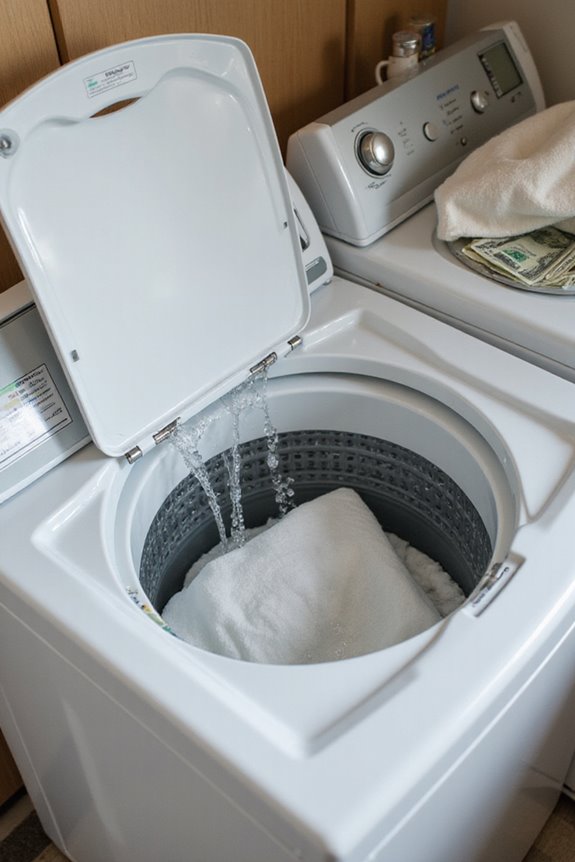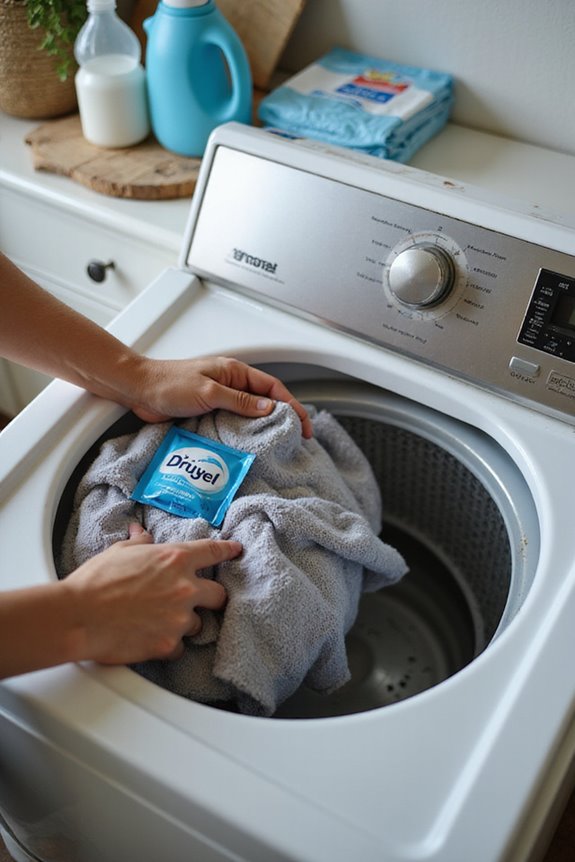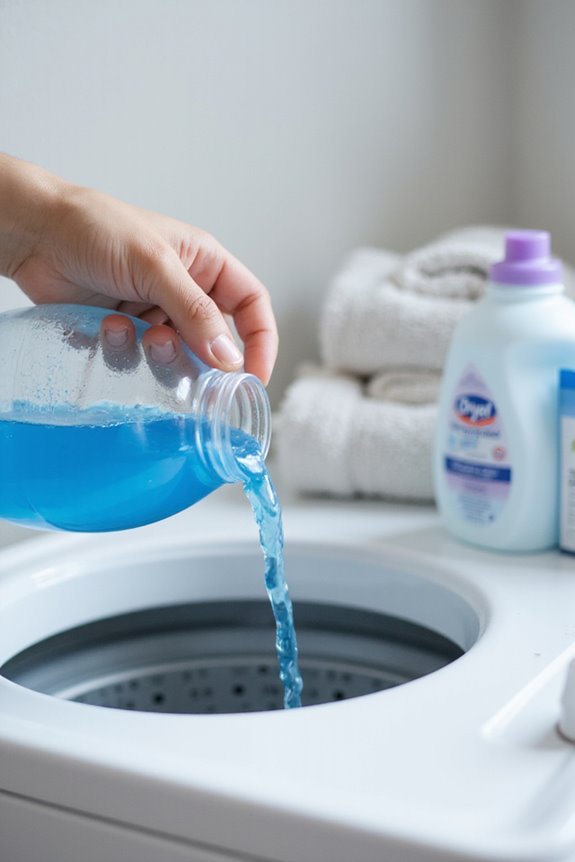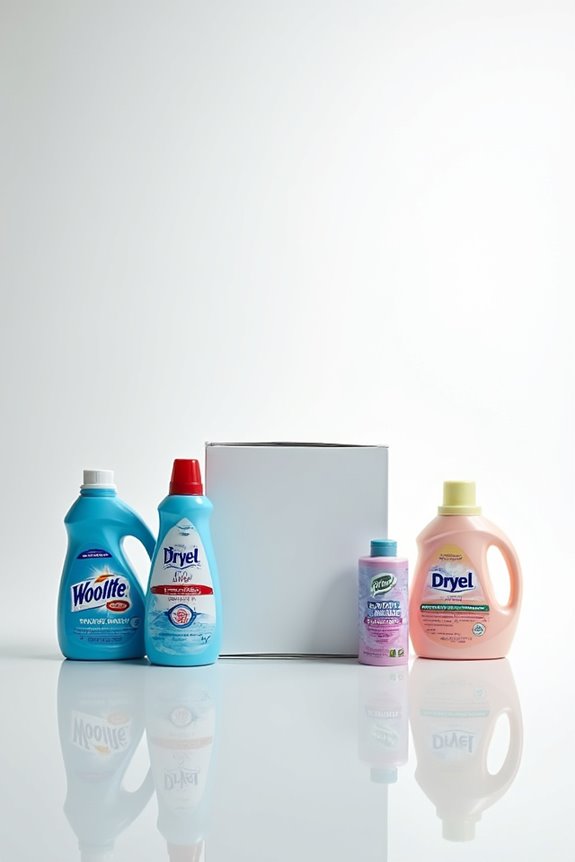We often find that top-load washers come with a few common problems. For starters, they usually struggle with cleaning tough stains compared to front-loaders. They can waste significant water, too, which isn’t great for our bills. Mechanical issues like noisy vibrations and poor load handling can be frustrating as well. Plus, they can be hard to load for those of us with mobility challenges. Curious about more specific issues we’ve encountered? Let’s explore further!
Key Takeaways
- Top-load washers often struggle with stain removal compared to front-loaders, affecting overall cleaning performance.
- Mechanical issues like agitator malfunctions and motor failures can hinder effective washing and operation.
- Excessive detergent use can lead to residue buildup, causing odors and inefficient cleaning.
- Loading accessibility issues arise due to deep tubs, making it hard for individuals with mobility challenges.
- Higher water and energy consumption in top-loaders can lead to increased utility bills compared to high-efficiency models.
Cleaning Performance Issues
When it comes to cleaning performance, top-load washers can sometimes leave us feeling a bit frustrated. We’ve all experienced that moment when a stubborn stain just won’t budge. It turns out, top-loaders aren’t as effective at stain removal compared to their front-loading counterparts. Plus, those pesky detergent residues can build up inside, leading to odors or even mildew.
We’ve noticed that using too much detergent can create excessive suds, making things worse. And let’s be honest, the agitators can be tough on our delicates, leaving us worried about damage. Regular maintenance is key here. So, let’s make sure we’re using the right amount of detergent and keeping an eye on buildup, or our laundry can end up less than fresh. Choosing a detergent with effective odor-fighting ingredients can help combat these issues and keep your clothes smelling great.
Water and Energy Efficiency Concerns

While we love the convenience of top-load washers, we can’t ignore the water and energy efficiency concerns that come with them. Older models can use up to 40 gallons of water per load, which isn’t great for water conservation. Even high-efficiency (HE) top-loaders still use more water than front-loaders, which can get by with about 14 gallons.
This extra water leads to higher energy consumption, especially since heating that water takes power. We’re all about energy savings, right? Luckily, ENERGY STAR certified washers help by using 25% less energy and 33% less water. Investing in these models can make a big difference, not just for our bills but also for the environment. So, let’s wash smarter!
Mechanical and Operational Problems

Mechanical and operational problems can really put a damper on our laundry routine. We often face suspension failures, where worn rods make our washer bounce like a trampoline. Then, there are agitator malfunctions; if the agitator isn’t working, our clothes won’t get clean. Motor issues can leave our washer motionless, while electrical problems can stop it from starting altogether. Remember that time our washer just wouldn’t turn on? A quick check revealed a faulty lid switch! Noise vibrations are also a common nuisance. An unbalanced load can make it shake like a mini earthquake. With proper maintenance and a keen eye for these issues, we can keep our top-load washer running smoothly and avoid turning laundry day into a circus act!
Durability and Reliability Factors

Understanding the durability and reliability factors of top load washers can really help us make informed choices. When we look at durability assessments, we notice that top load washers typically last around 14 years—better than front loaders! Brands like Speed Queen, LG, and Whirlpool shine here, often lasting over a decade with good care.
Now, regarding reliability metrics, the average repair rate ranges from 3.2% to 7%. LG and Speed Queen are at the lower end, thanks to their simpler designs and quality control. It’s interesting that more complex features can lead to more repairs. So, when shopping, let’s consider durability and reliability together, ensuring we choose a washer that’ll stand the test of time—and our laundry loads!
Physical and User Convenience Issues

Have you ever wondered how user-friendly a top load washer really is? While they seem convenient, we often face some physical and user convenience issues. Loading accessibility can be a challenge, especially with deep tubs that require lifting heavy laundry. For those of us with back problems or limited mobility, it can feel like a workout! Plus, if our laundry room has low ceilings, these machines can be a tight fit. We also can’t stack them with dryers, limiting space-saving options. Opening the lid during wash cycles can feel cumbersome in smaller areas. And let’s not forget, mid-cycle access is often tricky, depending on the model. Overall, top load washers might not be the most ergonomic choice for everyone.
Fabric Care and Wear Considerations
When we think about fabric care, it’s easy to overlook how our choice of washer can impact our clothes. Top load washers, especially those with agitators, can lead to fabric degradation and increased microfiber shedding. This happens because the vigorous agitation can wear out delicate fabrics, causing them to tangle and tear.
Plus, smaller loads tend to release even more microfibers due to the higher water-to-fabric ratio. We’ve all seen those pesky little balls of fabric pilling on our favorite shirts, right? To help our clothes last longer, we should choose the right detergent, avoid overloading, and wash full loads whenever possible. Additionally, selecting hypoallergenic and pH-neutral detergents is crucial for preserving the integrity of delicate fabrics. It’s all about striking that perfect balance for fabric care!
Noise Levels During Operation
A noisy top load washer can turn laundry day into a bit of a headache. We’ve all experienced that jarring sound during the spin cycle. Often, it’s the tub bearings or suspension springs at fault. Worn bearings lead to grinding noises, while broken springs cause unbalanced tubs, resulting in rattling. To tackle this, we can focus on noise reduction and vibration control. Replacing worn parts, like suspension springs, can restore quiet operation. If the drain pump squeaks, check for debris blocking it. Identifying these issues early can help us avoid further damage and keep our washers running smoothly. So, let’s keep our ears tuned in to those sounds and act before they become bigger problems!
Maintenance and Repair Challenges
After tackling those annoying noise levels, it’s time to turn our attention to maintenance and repair challenges that can pop up with top load washers. We often find ourselves facing mechanical wear and tear, especially with parts like belts and drive motors. Regular maintenance tasks, like cleaning detergent dispensers and checking hoses, can help extend the life of our machines. But if we skip these, we might be looking at hefty repair costs down the line. It’s also worth noting that overloading can lead to imbalance issues, causing extra strain on components. So, let’s take a moment to care for our washers, ensuring they keep running smoothly and efficiently. After all, nobody wants a laundry disaster!
Limitations of Wash Cycles
While we all love the convenience of top load washers, their wash cycles come with some limitations that can leave us scratching our heads. For starters, cycle customization often isn’t as detailed as we’d like. We might find ourselves wishing for more precise settings for different fabrics. The longer cycles, like heavy-duty ones, can take up to two hours—yikes! And while top loads are great for bulky items, they can struggle with delicate fabrics. They don’t always adapt easily to different load types. Some newer models are better, but we still miss the efficiency and options that front loaders provide. So, while we’re washing away, we may just need to accept a few quirks in our top load cycles!
Design and Space Constraints
We’ve talked about the quirks of wash cycles, but let’s shift our focus to the design and space constraints of top load washers. These machines take up more horizontal space, making them tricky for small laundry rooms. Plus, their non-stackable design limits our options for space optimization. The lid needs clearance above, which can complicate placement under cabinets. While they aim for ergonomic design, reaching the bottom of the drum can be a stretch, literally. We’ve all been there—awkwardly bending and stretching just to grab that stray sock. And without pedestal options, customizing our setup can feel pretty limiting. In short, top loaders can be a bit of a space hog, but they sure do get the job done!
Frequently Asked Questions
How Do I Choose the Right Detergent for My Top-Load Washer?
To choose the right detergent for our top-load washer, we should consider detergent types like liquid, powder, or pods. Following washing tips and checking compatibility guarantees effective cleaning while preventing issues like residue buildup.
Can Top-Load Washers Handle Larger or Bulkier Items Like Comforters?
Imagine our comforters swirling like clouds in a vast sky. Yes, top-load washers can handle larger items, as long as they have sufficient comforter capacity and can support the washer weight without compromising performance.
What Are the Best Practices for Loading a Top-Load Washer?
When loading our top-load washer, we should use proper loading techniques for maximum capacity. We’ll sort fabrics, distribute items evenly, and avoid overloading to guarantee effective cleaning and maintain our machine’s performance.
How Can I Reduce the Vibration of My Top-Load Washer?
To keep our washer steady like a ship on calm waters, we should guarantee proper washer leveling and load balancing. By redistributing clothes evenly, we can minimize vibrations and achieve a smoother wash cycle together.
What Should I Do if My Washer Smells Bad After Use?
If our washer smells bad after use, we should follow odor removal and maintenance tips. Let’s keep the lid open, run cleaning cycles, and promptly remove wet clothes to prevent unpleasant odors from developing.





